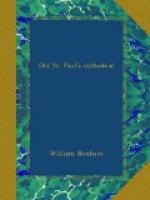JOHANNES DONNE Sac. Theol. Profess. Post varia studia, quibus ab annis Tenerrimis fideliter, nec infeliciter incubuit; Instinctu et impulsu Spiritus Sancti, monitu et hortatu Regis Jacobi, ordines sacros amplexus Anno sui Jesu, MDCXIV. et suae aetatis XLII Decanatu hujus ecclesiae indutus, XXVII. Novembris, MDCXXI. Exutus morte ultimo die Martii MDCXXXI. Hic, licet in occiduo cinere, aspicit eum Cujus nomen est oriens.
[Transcriber’s Note: Below is the inscription, as it appears in the Illustration.]
IOHANNI DONNE SAC: THEOL: PROFESS: POST VARIA STVDIA QVIBVS AB ANNIS TENERIBVS FIDELI TER NEC INF[OE]LICITER INCVBUIT INSTINCTV ET IMPVLSV SPIR SCTI: MONITV ET HORTATV REGIS IACOBI ORDINES SACROS AMPLEXVS ANNO SVI IESV 1614 ET SVE AETAT 42 DECANATVS RVTVS ECCLES: INDVTVS 27 deg. NOVEMB. 1621. EXVTVS MORTE VLTIMO DIE MARTII A 1631. HIC IACET IN OCCIDVO CINERE ASPICIT EVM CVIVS NOMEN EST ORIENS.
The unique interest attaching to this monument is in the fact that it was saved from the ruins of the old cathedral and now adorns the wall of the south choir aisle.
There are three more Bishops of this later period.
JOHN STOKESLEY (1530-1539) distinguished himself by his zeal in burning Bibles, and using all his influence on the side of Henry VIII. on the divorce, by his burning of heretics, and by his desire to burn Latimer. Froude tells the whole story with vivid pen. Stokesley was buried in St. George’s Chapel in the N.E. corner of the cathedral. He was the last of the pre-Reformation bishops buried in St. Paul’s.
THOMAS RAVIS (1607-1610) was buried in the N. Aisle, with simply a plain grave-stone telling that he was born at Malden in Surrey, educated at Westminster and Oxford, Dean of Christ Church and Bishop of Gloucester. But a most vigorous epitaph of him was written by his friend and successor at Christ Church, Bishop Corbet, namely, a poem in which extolling his virtues and his piety, he declares that it is better to keep silence over his grave, considering the profanation which is daily going on in the cathedral, the “hardy ruffians, bankrupts, vicious youths,” who daily go up and down Paul’s Walk, swearing, cheating, and slandering. And he sums up thus:—
“And wisely do thy grieved friends
forbear
Bubbles and alabaster boys to rear
On thy religious dust, for men did know
Thy life, which such illusions cannot
show.”
JOHN KING (1611-1621) was the last bishop buried in Old St. Paul’s.
Some of the greatest English painters are buried in the present cathedral. In Old St. Paul’s rested the bones of Van Dyck, who may almost be called the founder of English portrait painting, though he was a foreigner by birth, and only an adopted Englishman. He was born in Antwerp in 1599, became a pupil of Rubens, and, by general consent, surpassed him in portrait painting. In this branch of art he is probably unrivalled. He took up his residence in England in 1632, and was knighted by Charles I. He died at a house which that King had given him at Blackfriars, December 9th, 1641, and was buried close by John of Gaunt.




